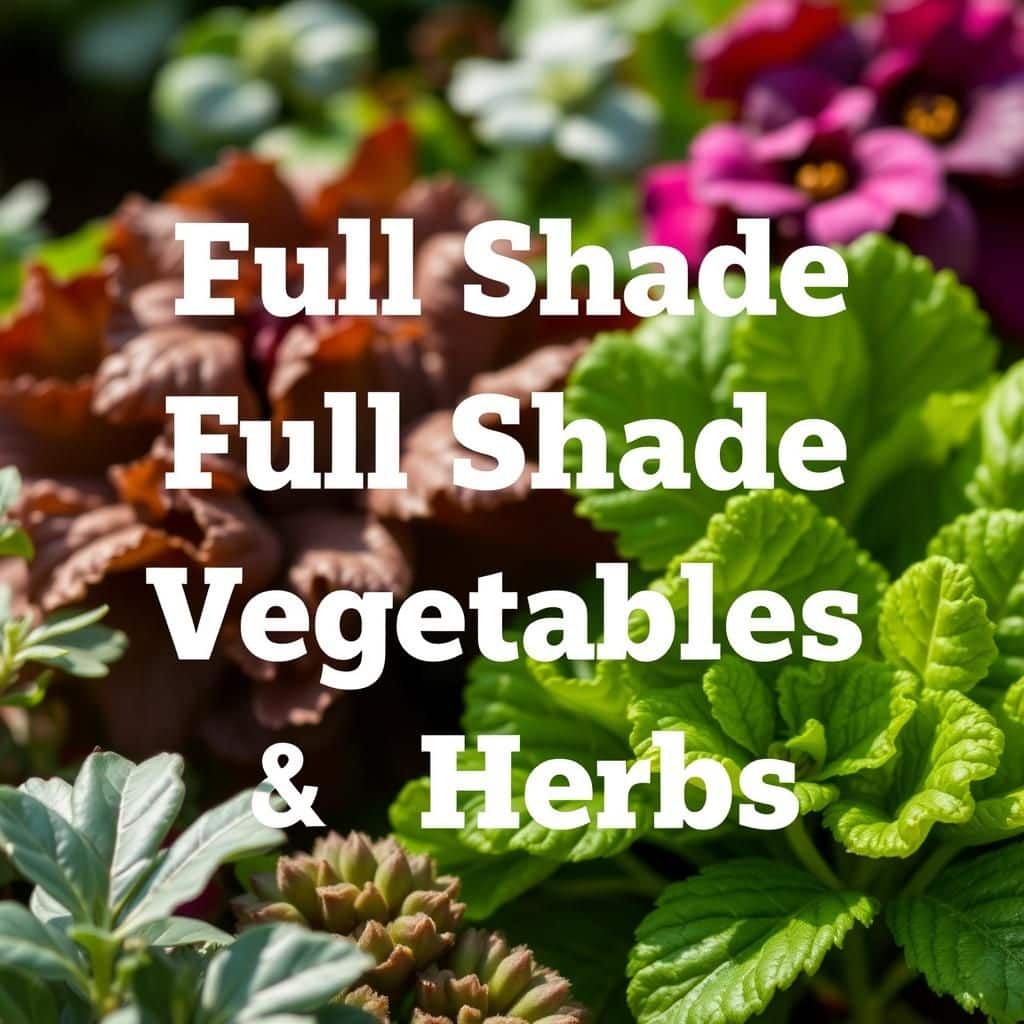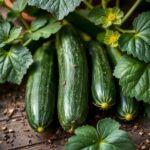Discover the Best Full Shade Vegetables and Herbs for Your Garden

When it comes to gardening, the challenge of growing vegetables and herbs in full shade can often deter many gardeners. However, a shaded garden space doesn't have to mean a lack of fresh produce. There are numerous varieties of vegetables and herbs that thrive in low-light conditions, offering a bounty of flavor and nutrition. In this article, we will explore the best full shade vegetables and herbs, highlighting their growth requirements, benefits, and tips for successful cultivation. Discover how to transform your shaded areas into a vibrant and productive garden oasis, even when sunlight is limited.
Understanding Full Shade Vegetables and Herbs
Many gardeners are often challenged by areas in their yards that receive full shade, making it difficult to cultivate traditional vegetables and herbs. However, a variety of shade-tolerant options thrive in these conditions, allowing you to maximize your garden's potential even in the dimmest corners. Full shade is typically defined as areas that receive less than 3 hours of direct sunlight daily, making it essential to choose plants that can grow in cooler, less illuminated environments. Some of the best choices include leafy greens, root vegetables, and various herbs, all of which can offer delicious results despite minimal sunlight. By understanding the needs and growth habits of these plants, you can successfully incorporate them into your garden plan.
Best Vegetables for Full Shade
Certain vegetables actually prefer or tolerate full shade and can flourish without direct sunlight. Lettuce, spinach, and arugula are among the top choices, as these leafy greens develop well in cooler temperatures and can maintain their flavor without the intense heat of full sun. Additionally, vegetables like beets and radishes are also suitable for shaded areas; their roots grow nicely underground while their greens can still thrive with minimal light exposure. Maintaining moisture is crucial in these shaded environments, promoting healthy growth and sustaining yields.
Herbs that Thrive in Shade
When it comes to herbs, a variety can adapt well to full shade conditions. For instance, mint, parsley, and cilantro are notable options that can develop strong flavors even in limited sunlight. These herbs not only add taste to your culinary dishes but also benefit from the cooler aspects of shade, which can prevent them from bolting prematurely. Additionally, lemon balm and chives can also flourish in these conditions, providing fragrance and flavor in a shaded garden space.
Soil and Watering Needs
In full shade, the soil type and watering schedule become vital in determining the success of your vegetable and herb plants. It's essential to use a well-draining potting mix enriched with organic matter to promote healthy root growth. Amending soil with compost can enhance nutrient availability and moisture retention. Furthermore, while plants in shade often require less watering than those in sun, it's crucial to keep a consistent moisture level, ensuring that the soil does not dry out completely. Regular monitoring of soil moisture can help achieve the perfect balance.
Companion Planting in Shade
Companion planting is an excellent strategy for optimizing your shaded garden. Certain plants can benefit from being grown together; for example, garlic and chives can help deter pests that may harm your herbs and vegetables. Additionally, pairing leafy greens with herbs can maximize the use of space and resources. Utilizing plant combinations that support each other can create a harmonious environment, enhancing growth and potentially boosting the yield of shade-tolerant crops.
Harvesting Shade Vegetables and Herbs
Proper harvesting techniques are essential to maximize the yield and maintain the health of your full shade vegetables and herbs. Regularly harvesting leafy greens like lettuce and spinach encourages the plants to produce more leaves rather than bolting. For herbs such as mint or cilantro, cutting the leaves above the node can promote further growth. It’s important to harvest consistently and judiciously to maintain the plant's vigor and prolong the growing season. Additionally, understanding the best time to harvest each type of vegetable or herb ensures optimal flavor and texture.
| Vegetable/Herb | Ideal Conditions | Harvest Time |
|---|---|---|
| Lettuce | Full shade, moist soil | 30-60 days |
| Spinach | Cool temperatures, partial shade | 30-45 days |
| Mint | Shade to partial shade | 8-10 weeks |
| Radishes | Moist soil, cooler temps | 22-60 days |
| Cilantro | Full shade to partial shade | 50-70 days |
Are there any vegetables that grow in full shade?

Yes, there are several vegetables that can grow well in full shade, although the options are relatively limited compared to those that thrive in full sun. Many vegetables require a certain amount of sunlight to develop properly; however, some can adapt to lower light conditions. The key is to choose shade-tolerant varieties and understand that while they may not produce as abundantly as sun-loving plants, they can still yield satisfying crops.
Shade-Tolerant Vegetables
Shade-tolerant vegetables are specialized crops that can survive and even thrive in low-light conditions. These vegetables have adapted to receive less sunlight, allowing them to grow in shady areas where traditional garden plants might fail. Some examples include:
- Leafy Greens: Varieties like spinach and lettuce are excellent choices for shaded areas, as they grow quickly and can tolerate less light.
- Root Vegetables: Vegetables like carrots and beets can also survive in partial shade, though they may take longer to mature.
- Herbs: Some herbs, including mint and chives, flourish in low-light environments.
Factors Affecting Growth in Shade
While some vegetables can grow in full shade, specific factors play a crucial role in determining their success. The amount of light, moisture, and soil quality can significantly influence crop yield. Continuous shade from tall trees or structures may stunt growth, emphasizing the need for understanding the environment. Key considerations include:
- Quality of Light: Even in shaded areas, indirect sunlight can benefit some vegetables, so consider the light's intensity.
- Moisture Control: Shaded soils can retain moisture longer, so adjust watering schedules to prevent over- or under-watering.
- Soil Fertility: Enriching the soil with organic matter can help provide the necessary nutrients for growth.
Recommended Vegetables for Full Shade
Several vegetables are specifically recommended for full shade conditions. They are known for their resilience and ability to thrive in environments with limited sunlight. Some of the most suitable include:
- Kale: This leafy green is not only shade-tolerant but also thrives in cooler temperatures typical of shaded areas.
- Radishes: They grow quickly and can develop fine even in partial shade, making them perfect for a speedy harvest.
- Brussels Sprouts: Although they prefer some sunlight, they can still yield decent crops in shaded regions.
Growing Techniques for Shade Vegetables
Utilizing proper growing techniques can enhance the yield of vegetables grown in full shade. Adapting certain practices can make a significant difference in their performance. To achieve the best results, gardeners should consider:
See also:
- Companion Planting: Pairing shade-tolerant plants with species that may provide some shading can maximize space and yield.
- Trellising: Using vertical gardening techniques can help create a better environment for light penetration.
- Frequent Harvesting: Regularly picking leaves from leafy greens can encourage further growth and extend the harvest period.
Common Misconceptions about Shade Gardening
There are many misconceptions surrounding the idea of growing vegetables in shade. Understanding these can help gardeners make informed decisions and avoid pitfalls. Here are a few common beliefs:
- Myth of No Growth: Many believe that nothing grows in the shade; however, many vegetables can flourish in low-light conditions if chosen wisely.
- Stunted Growth: It is often assumed that shaded vegetables grow poorly, but proper care can yield satisfactory results even in these conditions.
- Limited Variety: While there are fewer options compared to sun-loving plants, a range of productive vegetables exists for shaded gardens.
What will grow in 100% shade?
:max_bytes(150000):strip_icc()/shade-tolerant-impatiens-flowers-2132141-1-bd0a4240329940a2896d7a64282e67e1-d5a722cd2c5b4778b650c9781fa72964.jpg)
Growing plants in complete shade can be challenging, but there are several species that thrive in low light conditions. When choosing plants for such environments, it’s essential to consider their specific requirements, as well as the conditions of the soil and moisture levels. Below is a list of plants and information about how they can thrive in 100% shade.
1. Hostas
Hostas are one of the most popular perennials for shaded areas. They come in various sizes and colors, with their leaves often being large and lush.
- Diversity: Hostas can be found in shades ranging from deep green to creamy white.
- Low Maintenance: They require minimal care, making them ideal for beginner gardeners.
- Soil Preferences: They thrive in rich, well-drained soil with consistent moisture.
2. Ferns
Ferns are excellent choices for shady environments and come in many varieties. Their delicate fronds create a lush, green backdrop.
- Variety: Common types include the Lady Fern and the Ostrich Fern.
- Moisture Needs: Ferns prefer consistently moist soil and can suffer in dry conditions.
- Soil Type: They thrive in rich, organic matter and can help prevent soil erosion.
3. Astilbe
Astilbe is known for its stunning plumes of flowers that can brighten up a shaded garden.
- Flowering Season: Astilbe blooms in late spring to early summer, providing vibrant colors.
- Water Requirements: They prefer moist, well-drained soil and benefit from regular watering.
- Soil Conditions: Astilbe thrives in rich, organic soil and can benefit from added mulch for moisture retention.
4. Bleeding Heart (Dicentra)
The Bleeding Heart plant is renowned for its unique heart-shaped flowers that dangle from arching stems.
- Appearance: They add a delicate touch to any shaded spot with their unique shape and pastel colors.
- Growing Conditions: They thrive in cool, moist environments and prefer compost-rich soil.
- Summer Dormancy: After flowering, they may die back in summer but will return in spring.
5. Japanese Forest Grass (Hakonechloa macra)
Japanese Forest Grass is a beautiful ornamental grass that does well in shaded areas, adding texture and movement to gardens.
- Growth Habit: Its cascading foliage creates a soft, flowing appearance in garden beds.
- Light Tolerance: It prefers partial to full shade and can tolerate varying soil types.
- Maintenance: Requires minimal upkeep, making it a great option for busy gardeners.
Do any herbs grow in full shade?

Yes, there are several herbs that can thrive in full shade conditions. While many herbs prefer partial sunlight, certain varieties are well-adapted to low light environments and can grow successfully in shaded areas. The key to growing herbs in full shade is choosing the right species and ensuring they receive adequate moisture and nutrients.
1. Types of Herbs Suitable for Full Shade
Some herbs are particularly well-suited for growth in shaded areas. Here are a few popular options:
- Mint - Thrives in various conditions, including shade; produces aromatic leaves.
- Chives - Tolerates shade and produces green, onion-flavored shoots.
- Parsley - Can grow in shaded areas and is versatile in culinary uses.
- Thyme - Some varieties can adapt to shadier locations.
- Oregano - Generally prefers full sun but can tolerate partial shade.
2. Considerations for Growing Herbs in Shade
When growing herbs in full shade, certain factors play a crucial role in their success.
- Soil Quality - Ensure the soil is rich and well-drained; improve it with organic matter.
- Watering - Monitor moisture levels carefully, as shaded areas can retain water longer.
- Fertilization - Use a balanced fertilizer to provide essential nutrients for growth.
3. Benefits of Growing Herbs in Full Shade
Growing herbs in full shade has several advantages that make it appealing for gardeners.
See also:
- Space Utilization - Fully utilizing shaded areas in your garden can enhance overall productivity and aesthetics.
- Less Maintenance - Shade often provides a cooler environment, reducing the need for excessive watering.
- Unique Flavor Profile - Shade-grown herbs can develop a distinct flavor and aroma.
4. Challenges of Growing Herbs in Full Shade
Despite their advantages, there are challenges associated with growing herbs in full shade that gardeners should be aware of.
- Competition from Weeds - Shaded areas may harbor weeds that compete for nutrients and space.
- Pests and Diseases - Increased humidity in shaded areas can lead to fungal diseases.
- Limited Growth - Growth may be slower compared to herbs grown in full sun, requiring patience.
5. Tips for Successful Shade Herb Gardening
To maximize your success with herbs in full shade, consider the following tips.
- Monitor Light Conditions - Assess the level of shade to choose appropriate herb types.
- Regular Pruning - Keep plants healthy and encourage bushy growth by trimming them back periodically.
- Experiment with Varieties - Test different herbs to find which ones thrive best in your specific environment.
Can cucumbers grow in full shade?

Cucumbers (Cucumis sativus) are typically known to thrive in areas with full sun, requiring approximately 6 to 8 hours of direct sunlight each day for optimal growth. When it comes to their performance in full shade, the conditions can become problematic. Cucumbers are not well-suited to growth in shaded areas, as they depend heavily on sunlight for essential processes such as photosynthesis. In full shaded environments, cucumbers may exhibit stunted growth, poor fruit development, and an increased likelihood of disease due to poor air circulation and moisture retention.
Light Requirements for Cucumbers
Cucumbers thrive in bright light conditions. Assessing the light requirements of cucumbers is crucial because:
- Photosynthesis Efficiency: Cucumbers need light to create energy, and insufficient light leads to weak plants.
- Fruit Quality: Adequate sunlight typically results in higher yields and better quality fruit.
- Growth Rate: With more light, cucumbers tend to grow faster and develop more robust vines.
Effects of Shade on Cucumber Growth
Shade can significantly hinder the growth and development of cucumbers. The effects include:
- Stunted Growth: Cucumbers may develop slowly and fail to reach their full potential in shade.
- Poor Fruit Set: Limited light can reduce the number and quality of cucumbers produced.
- Sensitivity to Disease: Shaded conditions can encourage fungal diseases due to increased humidity.
Alternative Growing Conditions
If full sunlight is not possible, consider the following alternative conditions for growing cucumbers:
- Partial Shade: Cucumbers can tolerate some shade, particularly during the hottest parts of the day.
- Container Gardens: Growing in containers allows for mobility, enabling you to move plants to sunnier spots.
- Trellis Systems: Increasing air circulation and light exposure through vertical gardening may help in capturing more sunlight.
Shade-Tolerant Vegetables
In gardens where full sun is not available, consider planting these shade-tolerant vegetables alongside cucumbers:
- Lettuce: Thrives in cooler, shadier conditions and has fast growth.
- Spinach: Prefers partial shade and can be harvested multiple times.
- Radishes: Fast-growing and can adapt well to lower light levels.
Tips for Caring for Cucumbers in Less Sunlight
If you are growing cucumbers in less than ideal sunlight, here are some care tips to improve their chances:
- Soil Quality: Ensure high-quality soil with good drainage to prevent waterlogging in shaded areas.
- Fertilization: Use a balanced fertilizer to provide nutrients that support growth in suboptimal conditions.
- Maintain Airflow: Pruning plants can help to improve air circulation and reduce disease risk.
Questions from Our Readers
What are the best vegetables for full shade?
Full shade vegetables that thrive in low light conditions include leafy greens such as spinach, lettuce, and kale, as well as root vegetables like radishes and carrots. These plants are adapted to grow with minimal sunlight and can often produce tender, flavorful yields even in shaded areas.
Can herbs grow in full shade?
Yes, certain herbs can successfully grow in full shade. Options like mint, parsley, and cilantro are well-suited for low-light conditions and can enhance your culinary dishes while thriving in shaded gardens or containers.
How much moisture do shade-loving vegetables need?
Vegetables grown in full shade generally require consistent moisture, as they are less exposed to the sun’s heat. It is important to keep the soil well-drained yet moist, preventing it from drying out completely, which helps sustain healthy growth.
What is the ideal soil for growing shade vegetables and herbs?
The ideal soil for growing shade vegetables and herbs should be rich in organic matter, well-draining, and slightly acidic to neutral in pH. Incorporating compost or well-rotted manure can improve soil structure and nutrient content, promoting healthy plant development.
See also:

If you want to read more articles like Discover the Best Full Shade Vegetables and Herbs for Your Garden, we recommend you check out our Seeds category.
Leave a Reply
Related Articles